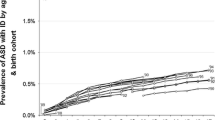Abstract
We have followed up a 2002 population study of autism prevalence in 15–24-year olds in the Faroe Islands. The rate of ASD grew significantly from 0.56% in 2002 to 0.94% in 2009. Although these results are within the range of typical findings from other studies, there were some interesting details. There were—in addition to 43 originally diagnosed cases in 2002—24 newly discovered cases in 2009 and nearly half of them were females. It is possible that unfamiliarity with the clinical presentation of autism in females have played a significant role in this context. There was diagnostic stability for the overall category of ASD over time in the group diagnosed in childhood (7—16) years, but considerable variability as regards diagnostic sub-groupings.
Similar content being viewed by others
References
American Psychiatric Association. (1994). Diagnostic and statistical manual of mental disorders (4th ed.). Washington: American Psychiatric Association.
Baron-Cohen, S., Scott, F. J., Allison, C., Williams, J., Bolton, P., Matthews, F. E., et al. (2009). Prevalence of autism-spectrum conditions: UK school-based population study. The British Journal of Psychiatry, 194, 500–509.
Billstedt, E., Gillberg, I. C., & Gillberg, C. (2005). Autism after adolescence: Population-based 13–22-year follow-up study of 120 individuals with autism diagnosed in childhood. Journal of Autism and Developmental Disorders, 35, 351–360.
Ehlers, S., & Gillberg, C. (1993). The epidemiology of Asperger’s syndrome. A total population study. Journal of Child Psychology and Psychiatry, 34, 1327–1350.
Ellefsen, A., Kampmann, H., Billstedt, E., Gillberg, I. C., & Gillberg, C. (2007). Autism in the Faroe Islands. An epidemiological study. Journal of Autism and Developmental Disorders, 37, 437–444.
Fernell, E., & Gillberg, C. (2010). ASD diagnoses in Stockholm preschoolers. Research in Developmental Disabilities, 31, 680–685.
Fombonne, E. (2008). Is autism getting commoner? The British Journal of Psychiatry, 193, 159.
Gillberg, C. (1991). Clinical and neurobiological aspects of Asperger syndrome in six family studies. In: U. Frith (Ed.), Autism and Asperger Syndrome (pp. 122–146). Cambridge: Cambridge University Press.
Gillberg, I. C., & Gillberg, C. (1989). Asperger’s syndrome: Some epidemiological considerations: A research note. Journal of Child Psychology and Psychiatry, 30, 631–638.
Gillberg, C., & Wing, L. (1999). Autism: Not an extremly rare disorder. Acta Psychiatrica Scandinavica, 99, 399–406.
Hallerbäck, M., Billstedt, E, Johansson, M, Gillberg, I. C., & Gillberg, C. (2011). Diagnostic Interview for Social and COmmunication Disorders—DISCO-11: The correspondence between the DISCO diagnosis and DSM-V. Unpublished manuscript.
Kopp, S., Kelly, K., & Gillberg, C. (2010). Girls with social and/or attention deficits: A descriptive study of 100 clinic attenders. Journal of Attention Disorders, 14, 167–181.
Lord, C., Risi, S., Lambrecht, L., Cook, E. H., Leventhal, B. L., & DiLavore, P. C. (2000). The autism diagnostic observation schedule-generic: A standard measure of social and communication deficits associated with the spectrum of autism. Journal of Attention Disorders, 30, 205–223.
Nygren, G., Hagberg, B., Billstedt, E., Skoglund, A., Gillberg, C., & Johansson, M. (2009). The Swedish version of the Diagnostic Interview for Social and COmmunication Disorders (DISCO-10). Psychometric properties. Journal of Autism and Developmental Disorders, 39, 730–741.
Philippe, A., Martinez, M., Guilloud-Bataille, M., Gillberg, C., Råstam, M., Sponheim, E., et al. (1999). Genome-wide scan for autism susceptibility genes. Paris Autism Research International Sibpair Study. Human Molecular Genetics, 8, 805–812.
Posserud, M.-B., Lundervold, A. J., & Gillberg, C. (2006). Autistic features in a total population of 7–9-year-old children assessed by the ASSQ (Autism Spectrum Screening Questionnaire). Journal of Child Psychology and Psychiatry, 47, 167–175.
Posserud, M.-B., Lundervold, A. J., & Gillberg, C. (2009). Validation of the autism spectrum screening questionnaire in a total population sample. Journal of Autism and Developmental Disorders, 39, 126–134.
Ronald, A., Happé, F., & Plomin, R. (2008). A twin study investigating the genetic and environmental aetiologies of parent, teacher and child ratings of autistic-like traits and their overlap. European Child and Adolescent Psychiatry, 17, 473–483.
Wechsler, D. (1981). Wechsler adult intelligence scale-revised. San Antonio: Psychological Corporation.
Wechsler, D. (1992). Wechsler intelligence scale for children (3rd ed.). London: Psychological Corporation.
Wing, L., Leekam, S. R., Libby, S. J., Gould, J., & Larcombe, M. (2002). The diagnostic interview for social and communication disorders: Background, inter-rater reliability and clinical use. Journal of Child Psychology and Psychiatry, 43, 307–325.
World Health Organization. (1993). The ICD-10 classification of mental and behavioural disorders. Diagnsotic criteria for research. Geneva: World Health Organisation.
Author information
Authors and Affiliations
Corresponding author
Appendix
Appendix
See Table 3.
Rights and permissions
About this article
Cite this article
Kočovská, E., Biskupstø, R., Carina Gillberg, I. et al. The Rising Prevalence of Autism: A Prospective Longitudinal Study in the Faroe Islands. J Autism Dev Disord 42, 1959–1966 (2012). https://doi.org/10.1007/s10803-012-1444-9
Published:
Issue Date:
DOI: https://doi.org/10.1007/s10803-012-1444-9




